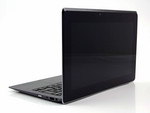Asus Taichi 21-CW001H
Especificações do Portátil

Price comparison
Média de 8 pontos (das 9 análises)
Análises para o Asus Taichi 21-CW001H
Revolutionary. One device designed for all jobs. Browsing, presentations, typing, mobility and working with a partner. The simple idea of installing a dual-TFT on the front and rear is to revolutionize using a Windows PC.
Origem: APC Mag
 EN→PT Archive.org version
EN→PT Archive.org versionWe’re used to seeing interesting designs when it comes to Windows 8 tablets and convertibles, but the Taichi takes the cake for originality.We’re not sold on the idea of twin displays and it’s obviously come at the cost of other components. If you can find a good reason to use both screens, there’s nothing else quite like the Taichi, although it feels more of a proof of concept than a usable solution.
Análise única, Disponível online, Curta, Data: 04/09/2013
Pontuação: Pontuação total: 70%
Origem: Computer Shopper
 EN→PT Archive.org version
EN→PT Archive.org versionThere's little arguing the fact that the Taichi is a well-built premium laptop. And both of its screens are of excellent quality. But like pretty much every hybrid or convertible we've seen so far, its split personality results in a compromised experience on both sides. As a tablet, the Taichi is powerful and responsive, but it's also about twice as heavy as most similarly sized dedicated tablets. And battery life is also pretty short by tablet standards.
Análise única, Disponível online, Longa, Data: 02/22/2013
Pontuação: Pontuação total: 70%
Origem: Techreview Source
 EN→PT Archive.org version
EN→PT Archive.org versionWindows 8 opened up new possibilities for mobile computing and the Asus Taichi 21 takes advantage of this. It has dual 11.6-inch 1080p displays where the second on the back of the primary display acts as a tablet when closed. Both of the displays look really good but the battery life is short. Asus really tried to keep the Taichi 21 light and compact and they certainly succeeded. It measures 12.1 x 7.8 x 0.7-inches (wdh) and weighs just shy of 3-pounds. The design is also eye-pleasing with an aluminum keyboard deck, sides and bottom with tapering edges to finish it off. Our only design question was why Asus put such a thick bezel around the primary display.
Análise única, Disponível online, Muito curta, Data: 01/28/2013
Pontuação: Pontuação total: 60%
Origem: V3.co.uk
 EN→PT Archive.org version
EN→PT Archive.org versionOverall, the Asus Taichi handled the Windows 8 OS very well, with very little lag when swiping between live tiles, and programs popped up almost as soon as we selected them. However, after installing a number of applications and storing a sufficient amount of data, we can imagine that it could slow down a bit.
Análise única, Disponível online, Média, Data: 01/11/2013
Pontuação: Pontuação total: 60%
Origem: Techradar
 EN→PT Archive.org version
EN→PT Archive.org versionThe Asus Taichi stands up as a supremely desirable piece of consumer tech that acts as a sterling showcase for Microsoft's Windows 8 operating system. Both power and usability are first class, and the design - as we've come to expect from Asus - really is head-turning. The Asus Taichi works better as a laptop than a tablet, but it's one of the best examples we've yet seen of marrying the two form factors together.
Análise única, Disponível online, Longa, Data: 12/06/2012
Pontuação: Pontuação total: 80%
Origem: Stuff TV
 EN→PT Archive.org version
EN→PT Archive.org versionThe Taichi’s screen-on-screen action could be exactly what some people want – be they business types, show-offs or just wildly popular Ultrabook users who never get any peace from their adoring fans. It is a touch too unwieldy to use as a touchscreen tablet to justify that £1200 price tag, but it’s already available for less so you may not have to stretch right up to the RRP.
Análise única, Disponível online, Muito curta, Data: 12/01/2012
Pontuação: Pontuação total: 80%
Origem: PC Pro
 EN→PT Archive.org version
EN→PT Archive.org versionMany manufacturers are struggling to find the most natural meeting point between the tablet and the laptop, and Asus’ own Windows 8 range provides yet more evidence of this. With its VivoBooks marrying touchscreens to standard laptops, the forthcoming VivoTab range mimicking the separate tablet and keyboard dock concept of the Android-powered Transformer Pad, and the Taichi 21 ploughing its own dual-screened furrow, it seems even Asus isn’t confident enough to put all of its eggs in one basket. Give it a few years and a refined, lighter chassis married with more power-efficient CPUs and improved battery life could see this dual-screened form factor present a compelling hybrid. At present, though, Asus’ Taichi 21 feels like a bold, innovative concept that’s just a little too far ahead of its time.
Análise única, Disponível online, Curta, Data: 11/22/2012
Pontuação: Pontuação total: 67% preço: 50% desempenho: 67% características: 67% ergonomia: 67%
Origem: Notegear
 KO→PT Archive.org version
KO→PT Archive.org versionAnálise única, Disponível online, Muito longa, Data: 01/07/2013
Comentario
Intel HD Graphics 4000: Placa de vídeo de processador na gama alta dos modelos Ivy Bridge. Oferece uma freqüência diferente nos diferentes modelos de CPU (ULV a quad core de desktop) e, portanto, um desempenho diferente.
Alguns jogos atuais não tão exigentes podem ser jogados fluentemente com poucos detalhes.
>> Mais informação pode ser encontrada na nossa Comparativa de de Placas de Vídeo e a Benchmark Lista.
3517U: Veloz CPU ULV baseado em Ivy-Bridge no segundo trimestre de 2012. Oferece uma freqüência de 1,9 - 3,0 GHz e um GPU HD 4000 (350 - 1150 MHz). O TDP é de 17 W.
>> Mais informação pode ser encontrada na nossa Comparativa de Processadores Móveis.




